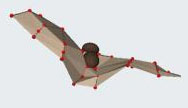PROVIDENCE, R.I. [Brown University] — Waving big, heavy wings around through the air all night would be an exhausting endeavor for a bat were it not for the newly discovered role played by tendons connecting their triceps and elbows. The tendons act like springs, researchers found, storing and releasing energy during flight to ease the burden on the muscles.
“We were interested in figuring out whether these tendons in the bat wing are elastic or not and if the are elastic, whether that had any negative or positive effects,” said lead author Nicolai Konow, a Brown University biology investigator. “We see a net decrease in the amount of work the muscle has to do on account of having the tendon.”
The tendon prevents the muscle from having to contract when doing so is hardest — on the wing’s upstroke. Instead the tendon releases its energy to make that happen, while the muscle recharges it on a different, more convenient cycle.
“The tendon is temporally decoupling the timing of muscle operation and the timing of joint movement,” said Konow, who made the findings, published in Proceedings of the Royal Society B in the lab of senior author Sharon Swartz, professor of biology and engineering at Brown University. “The muscle can do its work in a period where there is perhaps not as substantial an aerodynamic load on the wing.”
The researchers directly observed all this in four Seba’s short-tailed bats. They used a combination of high-speed X-ray video in Brown’s XROMM facility to precisely track the movement of bones, muscles, and tendons during flight. The tendon stretches by about 9 percent. They combined that with mechanical testing of the tendons and muscles to calculate how much force they contribute as they move.
It would be a simpler system if the tendons merely acted like stiff cables to transfer muscle power to the bones, Konow said, but instead the tendons are taking on the spring-like role of storing and delivering energy to help the muscles overcome inertia. In a flying robot, he said, duplicating this structure would require a more sophisticated control algorithm, but the payoff could be more efficient flight.
In addition to Konow and Swartz, the paper’s other authors are Jorn Cheney, Thomas Roberts, and J. Rhea Waldman.
The Air Force Office of Sponsored Research and the National Science Foundation funded the study.

